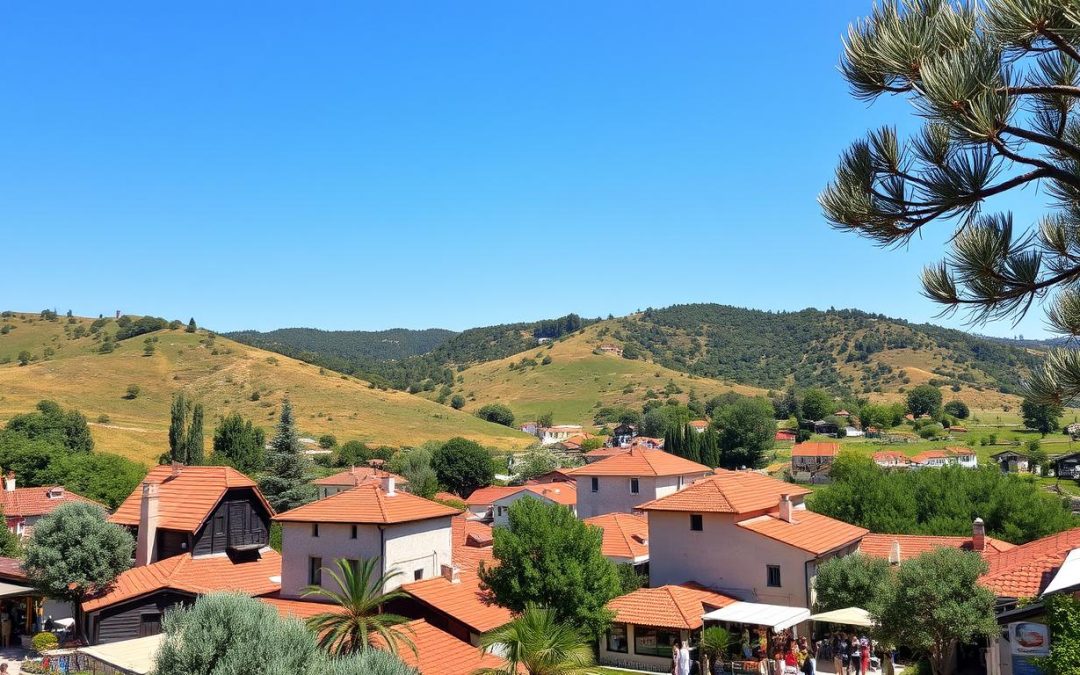Ever thought about how a small European nation keeps its language alive in today’s world? Croatia shows us how to preserve language and culture.
The Croatian language, known as Hrvatski, is more than words. It’s a symbol of national pride. Over 95% of Croatians speak it, making it a key part of their culture.
Exploring Croatia’s language scene, you’ll find a world of dialects and expressions. From Zagreb’s busy streets to the calm Adriatic coast, Croatian reflects the country’s rich culture.
Key Takeaways
- Croatian is spoken by approximately 5 million people globally
- The language features three primary dialects: Shtokavian, Kajkavian, and Chakavian
- Croatian is an official language in Croatia and Bosnia and Herzegovina
- The Croatian alphabet consists of 30 unique letters
- English is widely spoken in tourist areas and among younger populations
The Evolution of Croatian Language Through History
The Croatian language has a rich and complex history. It comes from the Slavic languages and has been shaped by many historical events. This has made Croatian a unique language that shows the nation’s vibrant culture.
From Latin to Slavic Influence
In the 6th and 7th centuries, South Slavic tribes came to the Balkans. They brought a language that would become part of the Serbo-Croatian group. Early Croatian was influenced by Latin, Germanic, Italian, and Ottoman Turkish.
- Latin administrative languages
- Germanic linguistic elements
- Italian regional vocabulary
- Ottoman Turkish linguistic contributions
Development of Modern Croatian
Croatian has many dialects, each with its own features. The main dialects are Štokavian, Čakavian, and Kajkavian. These dialects have shaped the language into what it is today.
| Dialect | Primary Region | Linguistic Characteristics |
|---|---|---|
| Štokavian | Eastern Croatia | Most widespread, basis of standard Croatian |
| Čakavian | Coastal regions | Distinct coastal linguistic variations |
| Kajkavian | Northern Croatia | Strong regional linguistic identity |
Standardization in the 19th Century
In the 19th century, Croatian language scholars worked hard to standardize it. They chose the Štokavian dialect as the basis for modern Croatian. This effort united the different dialects into one national language.
The standardization of Croatian was not just a linguistic endeavor, but a profound cultural statement of national identity.
Croatian has become a vibrant and dynamic language. It shows the nation’s rich cultural heritage. Its history and diversity make it a unique language.
Croatia: Official and Widely Spoken Languages
Explore the rich language scene in Croatia. Here, language shows the country’s cultural and historical depth. The official languages make Croatia a vibrant, multilingual society.
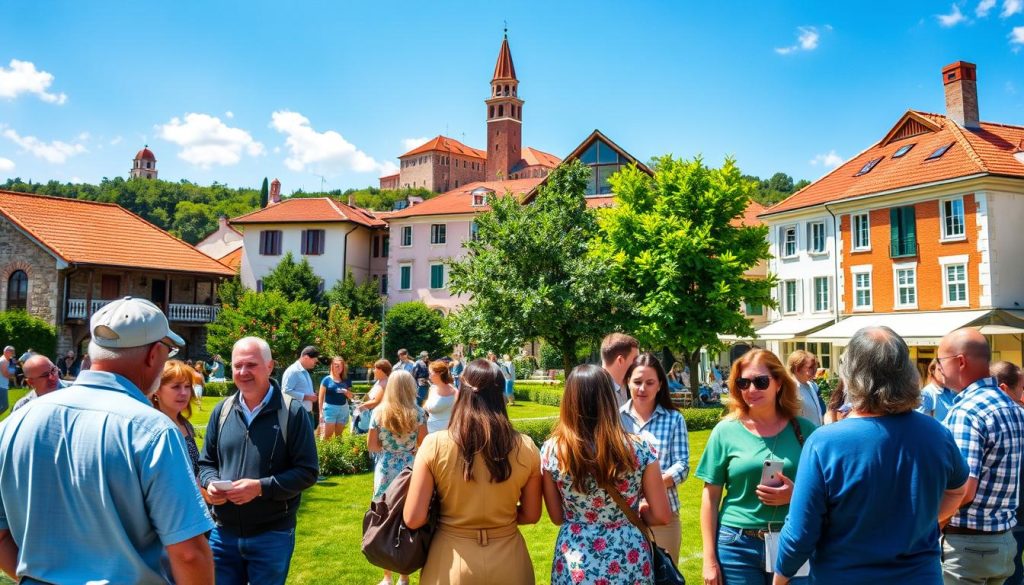
Standard Croatian: The National Language
Standard Croatian is spoken by 95% of people. It’s a strong cultural symbol. This language has grown over nine centuries, making it unique among Slavic languages.
- Spoken by approximately 95% of Croatian residents
- Developed through centuries of cultural influences
- Represents national identity and cultural heritage
Regional Variations and Dialects
Croatia’s language scene is rich with three main dialects: Shtokavian, Kajkavian, and Chakavian. Each dialect adds its own twist, showing local history and culture.
| Dialect | Region | Characteristics |
|---|---|---|
| Shtokavian | Most widespread | Base of standard Croatian |
| Kajkavian | Northern Croatia | Distinct pronunciation |
| Chakavian | Coastal regions | Unique linguistic features |
Written Systems and Alphabets
Croatian uses Gaj’s Latin alphabet. This writing system sets it apart from languages like Serbian, which uses Cyrillic. It shows Croatia’s ties to Western European languages.
“Language is the road map of a culture. It tells you where its people come from and where they are going.” – Rita Mae Brown
Learning about Croatia’s languages opens a world of dialects, culture, and identity. Your exploration will reveal the country’s rich history.
Croatian Language Demographics and Usage
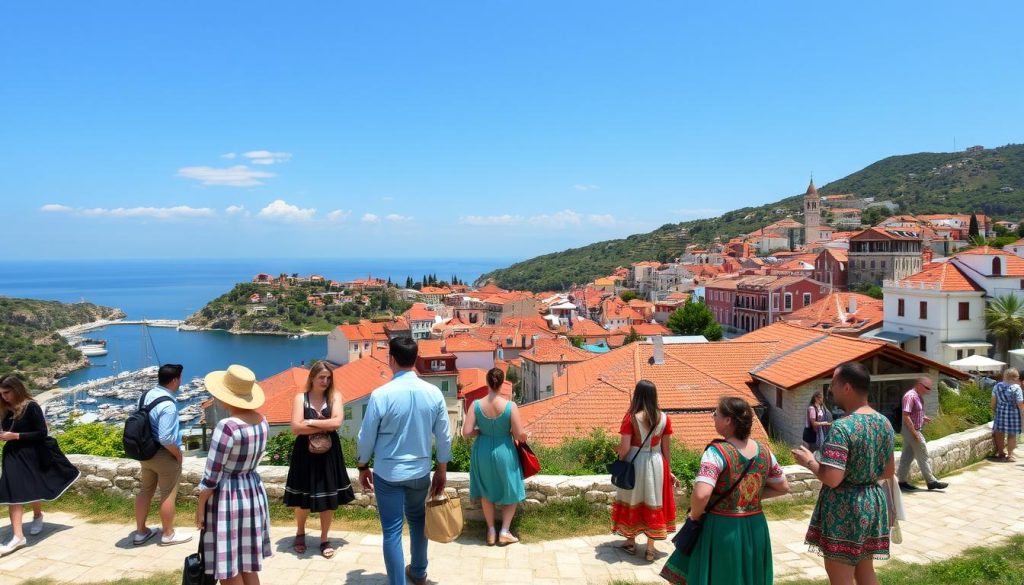
In Croatia, you’ll find a rich mix of languages that show the nation’s culture. The Croatian language is a key symbol of national pride. An impressive 95% of the population speaks it as their native language.
Looking at the numbers, Croatia has about 5.1 million native Croatian speakers as of 2021. The language is also important in other areas, including:
- Croatia (primary official language)
- Bosnia and Herzegovina (co-official)
- Montenegro (co-official)
- European Union official languages
“Language is the road map of a culture. It tells you where its people come from and where they are going.” – Rita Mae Brown
Croatia’s language scene is quite diverse. While Croatian is the main language, the country values speaking multiple languages. About 1.3 million people speak Croatian as a second language, showing how adaptable and widespread it is.
| Language Demographic | Percentage |
|---|---|
| Native Croatian Speakers | 95% |
| Serbian Speakers | 4.5% |
| Other Minority Languages | 0.5% |
Language policies in Croatia aim to keep cultural traditions alive. The country celebrates its language with events like the Days of the Croatian Language (March 11-17) and the Month of the Croatian Language (February 21 to March 17). These events highlight the importance of language in Croatian culture.
Major Dialects in Croatian Language System
Croatia’s language shows a rich mix of regional dialects. These dialects help us understand how people communicate in different parts of Croatia.
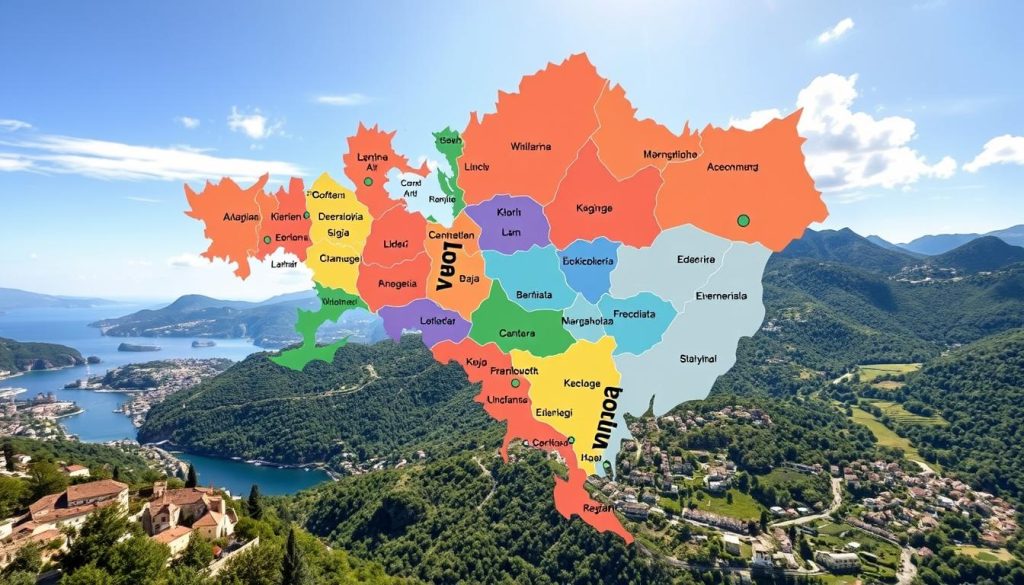
The Croatian language has three main dialects. They show how complex and varied Croatian speech can be:
- Shtokavian
- Kajkavian
- Chakavian
Shtokavian Dialect
Shtokavian is the most common dialect in Croatia. Linguistic research shows it’s the base of standard Croatian. It covers a big area, much bigger than its old limits.
“Shtokavian dialect reflects the dynamic linguistic evolution of Croatian communication.” – Croatian Language Institute
Kajkavian Dialect
In northwestern Croatia, like Zagreb, Kajkavian stands out. It has its own special way of speaking. This adds to Croatia’s rich language mix.
Chakavian Dialect
Chakavian is found along the Adriatic coast and islands. It’s a special part of Croatian speech. It keeps old ways of talking alive.
| Dialect | Primary Region | Distinctive Features |
|---|---|---|
| Shtokavian | Central and Eastern Croatia | Standard language basis |
| Kajkavian | Northwestern Croatia | Urban dialect |
| Chakavian | Coastal Regions | Maritime linguistic influence |
These dialects show Croatia’s amazing language variety. They reflect the country’s long history and cultural mix.
Minority Languages in Croatian Society
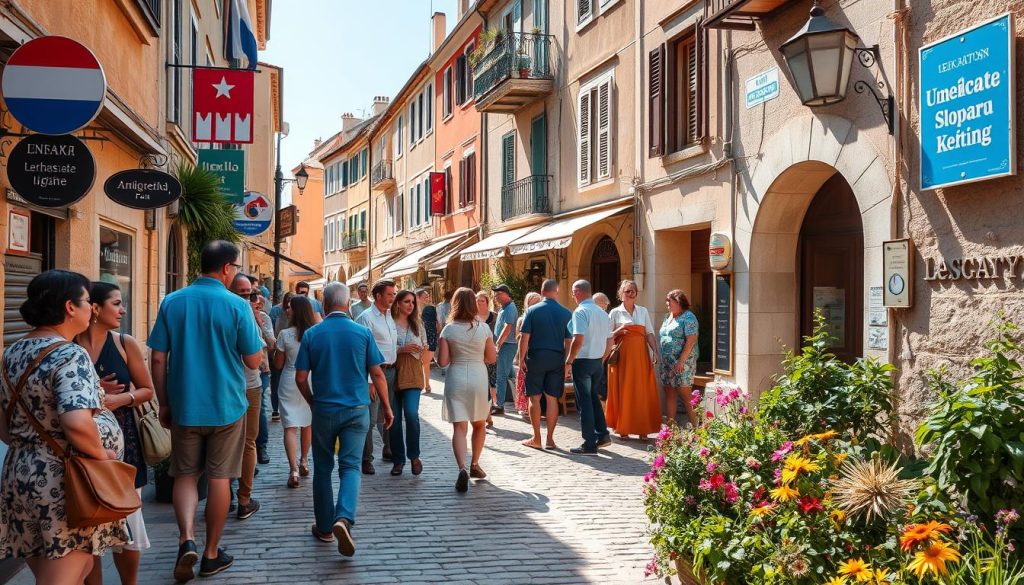
Croatia is more than just one language. It has a rich mix of minority languages that show its complex culture. The country values its linguistic diversity. It has laws that protect and support different ethnic groups.
The minority languages in Croatia are a colorful mix of cultures. Some of the main groups are:
- Serbian (about 5% of the population)
- Italian (around 20% of first-language speakers)
- Hungarian
- Czech
- Slovak
Knowing the laws about these languages is important. Croatia’s constitution protects the language rights of minority groups. This lets them keep their language and culture alive.
| Minority Language | Approximate Speakers | Official Status |
|---|---|---|
| Serbian | 5% | Recognized minority language |
| Italian | 20% | Official in some regions |
| Hungarian | Less than 1% | Protected minority language |
These minority languages make Croatia’s society richer. They show the country’s dedication to including all languages and cultures.
“Language is the roadmap of a culture. It tells you where its people come from and where they are going.” – Rita Mae Brown
Even though Croatian is the main language, with over 90% speaking it at home, Croatia celebrates its many languages. This diversity is a big part of its culture.
English Proficiency and Foreign Language Education
Croatia is known for its love of languages, with a big focus on learning foreign tongues. This shows the country’s dedication to talking to the world and sharing cultures.
English is a key language in Croatia, with people showing great skill in it. The country ranks 13th in the world for English, showing it’s very good at it.
English Language Prevalence
Students in Croatia get a lot of English training. By elementary school’s end, they’ve had about 700 English classes. The curriculum aims high for language skills:
- Foreign language learning starts in first grade
- By grade 8, almost half the students are very good at English
- English is the top choice for foreign languages
Foreign Language Learning Trends
The story of language education in Croatia is interesting. After World War II, the way people learned languages changed a lot:
- 1948: Russian’s importance in learning languages went down
- The 1950s and 1960s saw more English classes
- Students could pick from English, German, French, and Russian after the war
Tourism and Language Adaptation
The tourism in Croatia has made people better at speaking many languages. This has made the country’s language scene lively and diverse.
“Language is the road map of a culture. It tells you where its people come from and where they are going.” – Rita Mae Brown
| Language Learning Characteristic | Percentage/Details |
|---|---|
| English Proficiency Ranking | 13th out of 100 countries |
| Elementary English Classes | 700 classes by grade 8 |
| Students Above A2 Level | Almost 50% |
Exploring Croatia, you’ll see a society that loves languages. The country’s language policies help everyone communicate well with visitors from abroad.
Croatian in the European Union Context
When Croatia joined the European Union in 2013, it became the 24th official language. This was a big step for Croatian language policies and international recognition. It shows how Croatia’s language journey is tied to its cultural preservation and European integration.
EU membership changed how Croatian is used in official settings. More translation services were added, so Croatian speakers could get important documents in their language. This shows the EU’s commitment to language diversity.
“Language is the road map of a culture. It tells you where its people come from and where they are going.” – Rita Mae Brown
- Croatian became an official EU language in 2013
- Expanded translation services for official documents
- Increased international visibility for Croatian language
- Protection of linguistic heritage within EU framework
The EU’s language policies have opened up new chances for Croatia. By keeping its language while joining a multilingual space, Croatia shows the balance between keeping its culture and working with others.
| EU Language Statistic | Croatia’s Position |
|---|---|
| Total Official EU Languages | 24 |
| Croatia’s EU Accession Year | 2013 |
| Percentage of Croatians Speaking Foreign Languages | 34% (German), 14% (Italian) |
Looking into Croatian language policies shows a world of language adaptation and cultural strength in the EU’s diverse communication world.
Cultural Impact of Linguistic Diversity
Croatia’s language is a colorful mix that shows off the country’s deep culture. The Croatian language is more than a way to talk—it’s a living piece of history and culture.
Literature and Media Representation
The many languages in Croatia greatly affect its books and media. Writers and journalists use different dialects to tell stories that feel real. This includes:
- Keeping alive old stories from different places
- Using local speech in today’s writing
- Media that includes all languages
Cultural Preservation Efforts
Keeping the language alive is a big goal for Croatian culture. Schools and projects to document languages are key to keeping Croatia’s language rich.
“Language is the roadmap of a culture. It tells you where its people come from and where they are going.” – Rita Mae Brown
Modern Communication Patterns
New tech is changing how Croatians talk. Social media and online chats are helping the language grow. Young people are using these tools to celebrate their language.
With about 19 million speakers nearby, Croatian is doing well. It shows how strong it is in a world that’s getting smaller.
Conclusion
Your journey through Croatia’s linguistic world shows a rich mix of language and culture. The Croatian language is key to national identity, with 95.60% of people speaking it at home. This shows Croatia’s complex history and vibrant culture.
Knowing the official languages in Croatia is more than just talking. It connects us to national history, local identity, and social life. The laws protecting minority languages show Croatia’s dedication to including everyone’s culture.
Croatia’s language scene is a sign of its strength and ability to change. It has Croatian as the main language and also Serbian, Hungarian, and others. This mix of languages makes Croatia stand out in Europe.
Exploring Croatia’s language world, you’ll see a system that keeps growing and changing. The mix of keeping old traditions and using new ways to talk makes Croatia’s language world very interesting.
The above is subject to change.
Check back often to TRAVEL.COM for the latest travel tips and deals.
Here are some Tours & Sightseeing suggestions that might pique your interests!
